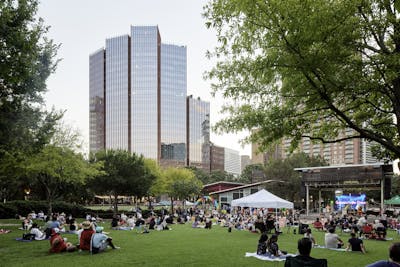
Bank of America Tower
Visionary build charts new frontier in sustainability
Project Facts
| Location | Houston, Texas |
| Owner | Skanska Commercial Development |
| Size | 700,000 SF |
| Cost | $185 million |
| Status | Completed 2019 |
| Capacity | 1,360 spaces |
| Certifications | LEED Platinum |
Overview
The concrete mix developed for this building introduced a new sustainable material to the industry—one that reduces carbon footprint without compromising integrity. It has since been adopted by numerous other projects, contributing to the advancement of sustainable construction practices. Bank of America Tower (formerly Capitol Tower) was the first in the U.S. to achieve LEED v4 Platinum Core and Shell Certification, and the highest-rated in the world at the time of its certification.
Services
Challenges
Unprecedented Sustainability Goal
The project team set out to achieve a goal that had never before been realized by an office building in the U.S.—LEED v4 Core and Shell Platinum certification. This raised the bar for environmental responsibility, energy efficiency, and workplace design.
Addressing Embodied Carbon
This was one of the country’s first major commercial developments to quantify building materials’ embodied carbon. A new approach was needed to drive meaningful emissions reductions at the material level.
Reuse vs. Rebuild
While the team initially explored options to repurpose the existing structure on site, economic and performance analyses revealed that demolition and rebuilding would be more viable—requiring a deeper commitment to sustainable new construction.
Solutions
Efficient Design
We engineered a cost-efficient structural frame that delivers column-free floorplates and up to eight corner offices per level—maximizing leasable area and long-term flexibility for tenants.
Carbon Accounting
Our team pioneered a new environmental accounting method using Whole Building Life Cycle Assessment (WBLCA) tools. This approach identified concrete as the primary contributor to embodied carbon and guided targeted emissions reductions.
Low-Carbon Concrete
We collaborated with suppliers for the 9,500-cubic-yard mat foundation to develop a custom concrete mix with significantly reduced Portland Cement content. This mix alone cut more than 3 million pounds of CO₂ compared to regional averages.
Green Infrastructure
Our civil engineers designed a rooftop water harvesting system that irrigates the 12th-floor landscaped terrace—an urban oasis featuring native plantings and stormwater management features.
Results
LEED Platinum
Bank of America Tower became the first U.S. office building to earn LEED v4 Core and Shell Platinum certification—and at the time of certification, the highest-rated project of its kind in the world.
Environmental Impact
Through thoughtful design and material selection, we achieved a 20% reduction in embodied carbon, a 13% drop in emissions contributing to ocean acidification, and a 35% reduction in ozone-depleting substances.
Urban Experience
The building’s three-story indoor plaza, rooftop garden, and tunnel-level daylighting create inviting public spaces that foster social interaction and enhance tenant experience.
Future Development
This project established a new benchmark for sustainable commercial development, showcasing how integrated design and engineering can deliver performance, beauty, and long-term value.



















